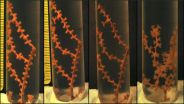(Press-News.org) LAWRENCE -- A team of scientists at the University of Kansas has pinpointed six chemical compounds that thwart HuR, an "oncoprotein" that binds to RNA and promotes tumor growth.
The findings, which could lead to a new class of cancer drugs, appear in the current issue of ACS Chemical Biology.
"These are the first reported small-molecule HuR inhibitors that competitively disrupt HuR-RNA binding and release the RNA, thus blocking HuR function as a tumor-promoting protein," said Liang Xu, associate professor of molecular biosciences and corresponding author of the paper.
The results hold promise for treating a broad array of cancers in people. The researcher said HuR has been detected at high levels in almost every type of cancer tested, including cancers of the colon, prostate, breast, brain, ovaries, pancreas and lung.
"HuR inhibitors may be useful for many types of cancer," Xu said. "Since HuR is involved in many stem cell pathways, we expect HuR inhibitors will be active in inhibiting 'cancer stem cells,' or the seeds of cancer, which have been a current focus in the cancer drug discovery field."
HuR has been studied for many years, but until now no direct HuR inhibitors have been discovered, according to Xu.
"The initial compounds reported in this paper can be further optimized and developed as a whole new class of cancer therapy, especially for cancer stem cells," he said. "The success of our study provides a first proof-of-principle that HuR is druggable, which opens a new door for cancer drug discovery. Many other RNA-binding proteins like HuR, which are so far undruggable, can also be tested for drug discovery using our strategy."
The research team evaluated about 6,000 compounds from both the KU Chemical Methodologies and Library Development Center and the Food and Drug Administration in a process known as "High Throughput Screening," hunting for compounds that obstruct HuR's interface with healthy human RNA.
The KU researchers confirmed the potential of the most promising compounds with cutting-edge techniques like Amplified Luminescent Proximity Homogeneous Assay, surface plasmon resonance, ribonucleoprotein immunoprecipitation assay and luciferase reporter functional studies -- verifying that six compounds with a similar "scaffold" could be starting points of novel cancer drugs to target the oncoprotein HuR.
"A cancer-causing gene, or oncogene, makes RNA, which then makes an oncoprotein that causes cancer or makes cancer cells hard to kill, or both," Xu said. "This is the problem we're trying to overcome with precision medicine."
The scientist said the HuR-RNA binding site is like a long, narrow groove, not a well-defined pocket seen in other druggable proteins targeted by many current cancer therapies.
"HuR tightly binds to RNA like a hand," Xu said. "The HuR protein grabs the 'rope' -- or the RNA -- at a site called 'ARE' on the rope. We aimed to find a small-molecule compound that makes the hand release the rope by competing with ARE of the RNA."
The research took more than 3 1/2 years and involved the collaboration of chemists, cancer biologists, computer modeling experts, biochemists and biophysicists at KU -- notably the labs of Xu, Jeffrey Aubé in the Department of Medicinal Chemistry and Jon Tunge in the Department of Chemistry.
Grants from the National Institutes of Health, along with funding from the state of Kansas, the Hall Family Foundation and Bold Aspiration funding from KU's Office of the Provost, supported the work.
For Xu, the findings are reflective of a personal commitment to improving odds for people diagnosed with cancer, the second-largest killer in the U.S. after heart disease.
"Trained as medical doctor and Ph.D., with both a grandfather and an uncle who died of cancer, I devoted my career to cancer research and drug discovery -- aiming to translate discovery in the lab into clinical therapy, to help cancer patients and their families," he said. "We hope to find a better therapy -- and eventually a cure -- for cancer."
INFORMATION:
Collaborators from KU and KU Medical Center include Xiaoqing Wu, Lan Lan, David Michael Wilson, Rebecca Marquez, Wei-chung Tsao, Philip Gao, Anuradha Roy, Benjamin Andrew Turner, Peter McDonald, Jon Tunge, Steven Rogers, Dan Dixon and Jeffrey Aubé.
As we age, the physical make up of our brains changes. This includes changes in neural processing in grey matter, but also in the deterioration of structural connections in the brain, which allow communication between distinct brain regions, so the brain is able to work as a well-wired network system.
Researchers at the Lifelong Brain and Cognition Lab at the Beckman Institute for Advanced Science and Technology at the University of Illinois have utilized the magnetic resonance imaging (MRI) facilities available in Beckman's Biomedical Imaging Center to measure the moment-to-moment ...
Every year, 300,000 pregnant women and 2,600,000 newborn babies are estimated to die worldwide, and more than 99% of these deaths occur in developing countries. Effective interventions to reduce maternal and neonatal mortality are critically needed, and an ongoing challenge for researchers and health professionals is finding the best way to deliver these interventions in resource-limited settings such as Mongolia. Antenatal visits can provide the first opportunity to deliver these interventions. Now, a new study has shown that Japan's flagship intervention, the Maternal ...
The question if humans can communicate via pheromones in the same way as animals is under debate. Cell physiologists at the Ruhr-Universität Bochum have demonstrated that the odorous substance Hedione activates the putative pheromone receptor VN1R1, which occurs in the human olfactory epithelium. Together with colleagues from Dresden, the Bochum-based researchers showed that the scent of Hedione generates sex-specific activation patters in the brain, which do not occur with traditional fragrances. "These results constitute compelling evidence that a pheromone effect ...
Well intentioned, but costly and potentially problematic. That's how researchers describe the end result of a decision by the Food and Drug Administration (FDA) to regulate colchicine, a drug used to treat gout, among other ailments. Fewer patients are actually now taking it, and it has come at a cost to their wallets, says study leader Aaron Kesselheim of Brigham and Women's Hospital and the Harvard Medical School in the US. The findings¹ appear in the Journal of General Internal Medicine,² published by Springer.
Colchicine had been sold at low cost for many ...
Shakespeare is such a towering literary figure that any new insight into the man, or his work, tends to generate a jolt of excitement in academic and non-academic communities of Shakespeare aficionados. Applying psychological theory and text-analyzing software, researchers at the University of Texas at Austin have discovered a unique psychological profile that characterizes Shakespeare's established works, and this profile strongly identifies Shakespeare as an author of the long-contested play Double Falsehood.
The findings are published in Psychological Science, a journal ...
The dispersant used to remediate the 2010 Deepwater Horizon oil spill in the Gulf of Mexico is more toxic to cold-water corals than the spilled oil, according to a study conducted at Temple University. The study comes on the eve of the spill's fifth anniversary, April 20th.
In this collaborative study between researchers from Temple and the Pennsylvania State University, the researchers exposed three cold-water coral species from the Gulf to various concentrations of the dispersant and oil from the Deepwater Horizon well. They found that the dispersant is toxic to the ...
April 9, 2015 - A wealth of studies have shown that violent video games contribute to antisocial and aggressive behavior. But what makes those games appealing in the first place?
One possibility is that storytelling plays a role, particularly if it lets players engage in meaningful choices.
A new study suggests that non-violent video games that capitalize on such storytelling have prosocial benefits that could ultimately be helpful to clinical disorders such as autism.
"The motivation to engage in and enjoy video games corresponds with principals that apply to ...
Scientists at the University of York have discovered a potential new treatment for prostate cancer using low temperature plasmas (LTPs).
Published in the British Journal of Cancer (BJC), the study is the first time LTPs have been applied on cells grown directly from patient tissue samples. It is the result of a unique collaboration between the York Plasma Institute in the Department of Physics and the Cancer Research Unit (CRU) in York's Department of Biology.
Taking both healthy prostate cells and prostate cancer tissue cells from a single patient, the study allowed ...
FROSTBURG, MD (April 9, 2015)--Nitrogen fertilizers make it possible to feed more people in the world than ever before. However, too much of it can also harm the environment. Professor Eric Davidson, director of the University of Maryland Center for Environmental Science's Appalachian Laboratory, has been leading a group of scientists, economists, social scientists, and agriculture experts in figuring out how to produce more food while lowering pollution at the same time. He calls it a "Mo Fo Lo Po": more food, low pollution.
"The main objective is to produce abundant, ...
MINNEAPOLIS/ST.PAUL (4/9/15) - Research published in the open access journal Microbiome offers new evidence for the success of fecal microbial transplantation (FMT) in treating severe Clostridium difficile infection (CDI), a growing problem worldwide that leads to thousands of fatalities every year.
Research led by Michael Sadowsky, Alex Khoruts, and colleagues at the University of Minnesota in collaboration with the Rob Knight Lab at the University of Colorado, Boulder, reveals that healthy changes to a patient's microbiome are sustained for up to 21 weeks after transplant, ...



